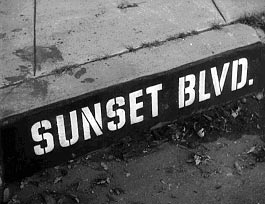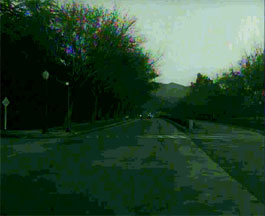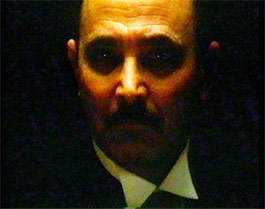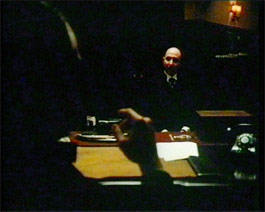|
The first seconds, the first image, the first scene. The way we enter a story is one of the most important elements in any great movie, and the signature of a gifted storyteller. In this article, we are going to look closely at three different opening shots, and at the opening scenes they are part of, each derived from a masterpiece in its respective genre. These are openings that access their material in three very different ways. When considered together, they can provide some insight into what makes the start of a film seem truly magnificent. The selected films are Sunset Boulevard (Billy Wilder, 1950), The Godfather (Francis Ford Coppola, 1972) and The Shining (Stanley Kubrick,1980). Sunset Boulevard
Billy Wilder directed this 1950 film noir classic, which tells the story of Hollywood B-writer Joe Willis (William Holden) and his fatal encounter with one of the silent era's forgotten stars; Norma Desmond (Gloria Swanson). In her desperate attempt to keep the young writer in her home, and ensure a return to the big screen, she ends up shooting him, and shortly after, as he lays dead in her pool, he starts telling the story of how things got that far. The start is extraordinarily fast, with the Paramount logo quickly dissolving to a pan down to a curbstone, where we immediately realize that Sunset Boulevard is both the name of the film, and also the name of the street, stenciled as it as on the curbstone itself. Without a cut, the camera begins to move back, the grey asphalt filling the screen, and superimposed over this are the credits, in the same stenciled style as we just saw on the street sign.  As the camera continues to move back, it still shoots down into the asphalt, until the credits are over. Then, 72 seconds into the shot, the camera slowly and still without a cut, pans up to show the entire street. Still moving backwards, we now see headlights down the road. The first lines of narration are spoken, by a voice the audience has yet to realize belongs to Joe Gillis. Yes, this is Sunset Boulevard, Los Angeles, California. It's about five o'clock in the morning. That's the homicide squad; complete with detectives and newspaperman. A murder has been reported from one of those great big houses on the 10.000 block.  The squad consists of two police motorcycles, followed by two police cars and an unmarked car. Just as the narrator gets to "the homicide squad", the second police car moves by, and the camera follows it with a swift pan to the left. The rest of the cars speed by, and the narrator continues to speak in his completely relaxed tone. He talks about the news hitting the street, and then he has a surprising line for a narrator: "…maybe you'll like to hear the facts, the whole truth. If so, you've come to the right party". By now we know that the narrator himself must be involved in the action, but we don't realize at this point that it's the man in the pool. Although we see the body in the pool, we can't clearly see the face. And to trick the audience even more, the narrator speaks of the body in the third person, in the same cynical fashion, as the whole movie describes Hollywood: "Nobody important really, just a movie writer with a couple of B-pictures to his credit". The fact that the narrator is laying in the pool when he speaks, is kept from the audience until the final scenes, where we see Norma Desmond shoot Joe Willis. The whole backward movement of the first shot is rather slow, but we instantly get a sense of immediacy when Franz Waxman´s score starts the second the paramount logo appears on screen. Clearly music for a chase sequence, though we don't understand what or who is being chased, or indeed who is trying to get away. As we quickly discover, for the man in the pool, it's too late to escape from anything, and instead the scene takes on an almost symbolic character. The man who spends the entire movie trying to escape his fate is Joe Willis, just as Norma Desmond is trying to escape her fate of being forgotten. Both characters are desperately trying to escape their fate, while chasing something else. The very first thing we see, the title: Sunset Boulevard, refers to the dream Joe Gillis is chasing, and the dreamlike life Norma Desmond once used to live. The sun is setting for Norma Desmond, and also for Joe Gillis, whose days as a Hollywood writer have just come to a sudden end, when the film starts. A film about a doomed escape, told backwards, and a first shot to mirror this structure; moving backwards also, because the past is the only thing that dead people can talk about. The Godfather The novel starts out with the undertaker, Amerigo Bonasera, in court, listening to a judge reading the sentences of the two boys who molested his daughter. The sentences are suspended, and this promptly triggers the already outraged Bonasera into making a crucial decision: "For justice, we must go on our knees to Don Corleone." [2] This is where the film starts: with Bonasera´s plea for justice, but the novel waits another 17 pages. These are used to introduce characters and subplots, almost entirely deleted in the movie. Coppola keeps the focus, and the subplots from the novel are mainly used to emphasize the power of the Corleone family. The whole movie revolves around the acquisition and maintaining of power, and therefore it makes perfect sense that the first shot visualizes this power. It does so in a subtle way, showing, not Don Corleone (Marlon Brando), the head of the family, but rather his power over other people.  The opening shot is a very slow zoom out, from a close-up of Amerigo Bonasera, to a framing in which he now only fills a small part of the screen, while the back of Don Corleone fills the entire left side of our visual field. This whole first shot takes the first 2 minutes and 44 seconds of a scene that runs in all just under 6 minutes. While Bonasera tell his story, the camera shows his relation to the man to whom he is talking. As the seconds go by, we feel the power of Bonasera diminishing and the power of the person whom we have so far seen only from behind, steadily growing. According to Walter Murch, post-production consultant and sound editor on the film, starting with the slow, zoom back was something Coppola had decided already in the writing of the screenplay: That particular technique of starting with a slow zoom back, while a character has a kind of aria in which he states his position... this is very similar to what Francis did in the beginning of Patton (...) Francis starts him (Bonasera) out in limbo - just a head, in darkness, saying: "I believe in America"... and yet there's a problem. What you want is the audience to say, Yes, I too believe in America, and I too am frustrated by this problem, either I have experienced it or I know people who have experienced it. As we're feeling this, the context in which this speech is being given is revealed, and eventually the shoulder of the man who will solve the problem comes into frame." [3]  Coppola makes the audience wait. When Don Corleone speaks his first line: "Why did you go to the police, why didn't you come to me first?" considering how long the shot has already been held, it would have been natural to cut to Don Corleone as soon as the line began. But instead, the camera stays on Bonasera, who says "What do you want of me? Tell me anything, but do what I beg you to do." And The Don replies dryly: "What is that?" Bonasera, too shy and insecure to speak his request out loud, gets up from his chair and walks over to Don Corleone, whispering: "For them to die" in his ear. As Bonasera starts moving away again, the long anticipated cut finally comes, and we see the face of The Don for the first time. The power of the Don is established in several ways throughout the first shot, one of the most subtle of which is seen when Bonasera breaks down from telling the story of his daughter, and Don Corleone moves his hand very slightly, and immediately a drink is served to the nervous undertaker. The space and the lighting are beautifully controlled elements in the portrayal of Bonasera and his desperate situation. He is completely surrounded by darkness, with only a small amount of light shining on his head, ina room that stands in extreme contrast to the festivities of the wedding party going on just outside. As the films set-designer Dean Tavoularis noted: "Here was this place which was beyond just a room, but a symbolic thing, kind of sticky pink, with sticky flowers and dark paneling. Kind of like a church. When you come out of a church you feel a bit more alive." [4] Coppolas first shot has managed to encompass the genre, the environment in which the film takes place, and one of the main themes in the story: power. It's an extremely slow shot, carefully planned and executed. A shot that itself embodies the qualities of the man it indirectly tries to describe. The Shining The film opens with a sequence of aerial shots lasting 2 minutes and 40 seconds, following a yellow car on it's way up an almost desolate mountain road. It ends with a cut to a title card that reads: "The interview". The first of the sequence's eight helicopter shots runs for 19 seconds, and starts above a mountain lake, then flying very close to a tiny island in the middle of it, and ends while still moving toward the mountain ahead. As with the other helicopter shots, this is shot in daylight, but nevertheless seems just as threatening as the start of any other horror movie. This is due largely to Wendy Carlos´ chilling gothic-like music, Dies Irae, which sets in as soon as the first shot begins, and continues throughout the rest of the opening sequence. It immediately makes the audience aware that evil is waiting at the end of the road, and after a minute and a half, several slow, aching screams are even beginning to be heard over the deep horns that have otherwise dominated from the start. The first shot is preceded by only the Warner Brothers logo, and so the opening montage also functions as the title sequence of the film. The Shining has Stanley Kubrick's first ever use of computerized credits, and they start in the fourth shot, scrolling up from the bottom, at a constant speed and with the text in light blue letters. Kubrick could obviously have started with a classical white on black credit sequence, distinct from the opening montage, but by having only the Warner Brothers logo and then immediately cutting to the fast-moving helicopter shot, he instantly creates the feeling of being drawn toward something. That something remains unknown for the first seven shots in the sequence, until the eighth and final shot, where the Overlook Hotel is finally shown. This shot also has the camera stopping its rapid forward motion, and instead of just flying over the hotel, it now slows down and moves sideways, observing the hotel from a distance, almost as if it feared coming closer. In the fourth shot, there is a notable change of the camera's position. After filming from about a hundred meters above the road in the second shot, and staying far behind the car in the third shot, the camera now suddenly descends and catches up with the car. It almost touches down on the mountain road behind it, but instead moves extremely close to the car, and continues over the cliff. The camera calls more attention to itself then it has in any of the previous shots, and thus suddenly changes from an almost neutral observer to an independent character in the film. Jack Torrance is being watched - by something that seems to be above and beyond his own awareness… something that knows where he is going. Either because this "something" has the gift of foresight, or because what Jack Torrance is about to do, is something he has done many times before. (As we later discover, foresight is one the meanings of the word "shining".) He is entering a maze, from which death inevitably becomes his sole escape, and as later suggested, he has probably done so before. This is a story of ghosts, and that fact is visually supported throughout the film. From the very first shot, the film is weightless, the camera flying through the air, as the steady-cam camera later "flies" through the endless hallways of the hotel, always right behind Danny and his tricycle. The final shot of the film has the camera moving slowly toward a wall covered with pictures, and stops on an old black and white photo, dated July 4, 1921. In the middle of a crowd, is Jack Torrance, appearing to be the same age as when the movie takes place, around 1980. This eerie ending connects not only with the start, but also with a line spoken earlier in the film by the ghost of Delbert Grady, whom Jack presumes to be the former caretaker. Grady corrects him, saying "…but you're the caretaker, you've always been the caretaker. I should know; I've always been here". Kubrick uses the mazes in the movie as an allegory of the story's structure and the state of mind into which Jack Torrance is slowly drifting. The yellow car of the opening shots is being drawn closer to the magnet of evil, and to a predestined fate. Kubrick has done as Wilder did in Sunset Boulevard, and embodied the film's story in the opening shots. | ||
|